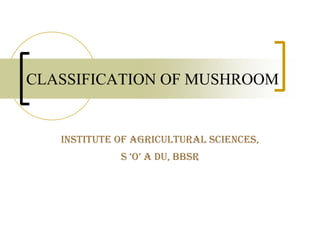
Classification of mushrooms
- 1. Institute OF AGRICULTURAL SCIENCES, s ‘o’ a du, BBsr CLASSIFICATION OF MUSHROOM
- 2. What are mushrooms? Classification Taxonomic Position Natural Habitat CONTENTS
- 3. Human Consumption Reference Mushrooms are fleshy, spore bearing fruiting body of a fungus, typically produced above ground, on soil or on it’s food source. 1.5 to 2 million species of mushroom present on earth, out of which 8000088000 species are identified. Among them 124 species are edible, from which 24-26 species are under cultivation and 4-6 species are commercially available. There are 3 basis of classification of mushrooms. What are mushrooms?
- 4. 1. Taxonomic position 2. Natural habitat 3. Human consumption Classification
- 5. 1. Taxonomic Position Fungi Eumycota Basidiomycotina Hymenomycetes Gasteromycetes Ascomycotina Discomycetes Pyrenomycetes KINGDOM DIVISION SUB DIVISION CLASS -Agaricales -Aphyllophorales -Hymenogastrales -Phallales -Pezzizales -Tuberales ORDER -Cordyceps -Hypomyces
- 6. In ecology a particular organism lives in a particular natural environment and gives best result. Inhabiting media Terminology Saprophytic Parasitic/ Symbiotic Humus Humicolous/ Folicolous Marasmiusspp. Volvariellaspp. Polyporous spp. Boletus Lactarius, Tricholoma spp. (S) Wood Lignicolous Agrocybespp. Pleurotusspp. Lentinus edodes Armillaria mellea Cyttariaspp. (P) 2. Natural Habitat
- 7. Dung Coprophilous Agaricusspp. Coprinus spp. A. Edible mushroom - Edibility may be defined by criteria that include absence of poisonous effect on human and desirable taste and aroma. 1) Paddy straw mushroom ( Volvariella volvacea ) 2) Oyster mushroom ( Pleurotus ostreatus ) 3) Button mushroom ( Agaricus bisporus ) 4) Milky mushroom ( Calocybe indica ) 5) Shiitake mushroom ( Lentinulla spp. ) Not available 6) Jew’s ear mushroom ( Auricularia spp. ) 3. Human Consumption
- 8. Paddy straw mushroom ( Volvariella volvacea ) Paddy straw mushrooms are extensively grown on paddy straw having fleshy stipe 3-8 cm in length and dark grey cap that is 6-12 cm in diameter.
- 9. Oyster mushroom ( Pleurotus ostreatus ) Oyster mushrooms are called as such as they look like oysters. They are soft and white in hot weather and greyish in cold weather. Stipe is usually very short and the color is as that of the pilus. The mushroom is fan like when young then gradually becomes deep lobed to form branches.
- 10. Button mushroom ( Agaricus bisporus ) The name is derived from it’s shape when it is quite young but the button stage is only a passive stage which becomes umbrella like on it’s maturity. The gills are enclosed by a membrane in the young stage that extends from margin of pilus to the stipe called as partial veil. It remains attached to the stipe where it forms a ring known as annulus.
- 11. Milky mushroom ( Calocybe indica ) Milky white mushroom is a species of edible mushroom native to India. The sturdy all white mushrooms appear in summer after rainfall in fields and on road verges.
- 12. Shiitake mushroom ( Lentinulla spp. ) This is an edible mushroom native to east Asia which is considered as a medicinal mushroom in some forms of traditional medicine.
- 13. Jew’s ear mushroom ( Auricularia spp. ) This mushroom is found worldwide and the fruiting body is distinguished by it’s noticeably ear like shape and brown coloration and grows upon wood.
- 14. Some mushrooms are not edible because of their growing environment or the way they smell or taste i.e quite unpleasant. Ex.- coprophilous fungi (grows on dung of cow other animals) Poisonous mushrooms are called as toadstools.
- 15. 1. Amanita phalloides ( Death cap ) - Amanita phalloides known as death cap, is a deadly poisonous basidiomycetes fungus widely distributed across Europe. - Amatoxins, the class of toxins found in these mushrooms are thermostable, so their toxic effects are not reduced by cooking. - The principal toxic constituents are alpha- amanitin, which damages the liver and kidneys, causing liver and kidney failures that are fatal.
- 16. 2. Amanita virosa (destroying angels )
- 17. - It is native to Eurasia and North America. - It belongs to a group known as Orellani, all of which are highly toxic. - Eating them results in kidney failure, which is often irreversible. 3. Cortinarius rubellus ( fool’s web cap )
- 18. ⁻ Amanita pantherine, also known as the panther cap and false blusher due to 4. Amanita pantherina ( Panther cap )
- 19. its similarity to true blusher (Amanita rubescens) found in Europe and western Asia. ⁻ The mushroom gives an unpleasant smell like raw potatoes.
- 20. 5. Amanita muscaria ( Fly agaric ) ⁻ ⁻
- 21. ⁻ Native to Europe and North America.
- 22. ⁻ The mushroom is an irregular brain shaped. ⁻ When mushroom is consumed, the principal active agent, Gyromitrin is hydrolyzed into the toxic compound mono methyl hydrazine. ⁻ This toxin affects the liver, central nervous system and sometimes the kidney. ⁻ Native to Europe and North America. ⁻ It is also known as sweating mushroom; it derives this name from the symptoms of poisoning (sludge syndrome). 6. Gyromitra esculenta ( False morel ) 7. Clitocybe rivulosa ( Fool’s funnel )
- 23. ⁻ The main toxin of this mushroom is Muscarine.
- 24. 8. Boletus satanas ( Devil’s bolete ) ⁻ ⁻
- 25. Class note Book- Mushrooms for livelihood by Vijaya Khader (page no.- 14-17) https://en.wikipedia.org/wiki/Calocybe_indica https://www.webmd.com/diet/health-benefits- shiitakemushrooms#:~:text=Shiitake%20mushrooms%20contain%20 eritaden ine%2C%20a,lentinans%20and%20other%20beta%2Dglucans https://www.delephant.com.au/black-fungus-wood-ear- healthbenefits/#:~:text=Easily%20prepared%20%E2%80%93%20ca n%20b e%20served,enriching%20blood%20when%20consumed%20regular l y https://en.wikipedia.org/wiki/Rubroboletus_satanas Reference